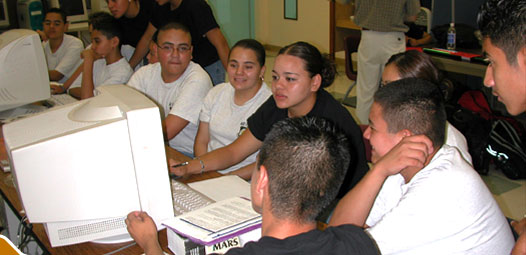Please note: The Academy will close at 3 pm on Thursday, April 18, for Big Bang Gala.
Science News
7th Graders Find Cave on Mars
June 28, 2010

NASA, overwhelmed by the volume of images being returned from Mars, needs help analyzing them. So, in partnership with Arizona State University, the space agency developed the Mars Student Imaging Program in 2004, making it possible for everyone from 5th graders to college sophomores to examine photos of the Martian surface and explore another world.
More than 50,000 students have participated, but none discovered anything like the 7th grade science class at Evergreen Middle School in Cottonwood, CA, did. Taught by Dennis Mitchell, the class of 16 students pored over images of the 8.6 mile high Martian volcano Pavonis Mons (whose name means “peacock mountain”), trying to determine whether lava tubes formed higher or lower on its slopes.
The images, taken by NASA’s Mars Odyssey spacecraft, which has been orbiting the Red Planet since 2001, revealed a dark pit that wasn’t a mere impact crater. The students found what appears to be a “cave skylight,” or an opening to an underground cave. The pit appears to measure about 500-600 feet across and may be about 380 feet deep. Cave skylights exist elsewhere on Mars, but this was the first one found on this particular volcano. The Evergreen science students announced their discovery after examining an image of a previously-discovered cave skylight on another part of Mars and noting the similarity with the one on Pavonis Mons.
Looks like they’ll have more pictures to look at in the 8th grade—according to Universe Today:
Now, because of this find, the HiRISE high resolution camera on the Mars Reconnaissance Orbiter will take follow-up images of the pit to provide a better look at the object. HiRISE can image the surface at about 30 centimeters (12 inches) per pixel, which may allow a look inside the hole in the ground.
Nice work, kids!